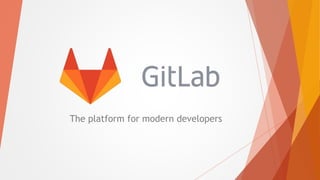
Git Lab Introduction
- 1. The platform for modern developers
- 2. Summary Gitlab Basics Gitlab Advantages Gitlab Features Git Overview Gitlab Software overview Setup Gitlab ( Demo ) Working Pattern ( Sample ) References
- 4. Gitlab Basics Like GitHub, GitLab is a web-based repository manager that lets teams collaborate on code, duplicate code to safely create and edit new projects, then merge finished code into existing projects. GitLab is written in the Ruby programming language and includes a Wiki and issue- tracking features. It has three separate versions: GitLab Community Edition (CE), Enterprise Edition (EE), and a GitLab-hosted version, GitLab.com. It’s got over 700 contributors and is used by major organizations like Alibaba, NASA, CERN, and more. GitLab is used by more than 100,000 organizations https://about.gitlab.com/
- 6. Gitlab Advantages A convenient user interface enables users to access everything from one screen: projects, latest projects, users, latest users, groups, and stats. Settings allow users to control whether a repository is public or private. “Snippet support” lets users share small pieces of code from a project, without sharing the whole project.
- 7. Gitlab Advantage Authentication levels take this security a step further, allowing users to give people access beyond a read/write level. For example, you can give a team member access to issue tracking without having to give them access to the code itself. Improved milestones enable you to set milestones at a group level, not just a developer-specific level. Developers can get insight into the whole team’s scope and view the entire project’s milestones, not just their own.
- 8. Gitlab Advantage Protected branches are a new way to keep code safe. They allow users to set higher permissions on a project, so only certain people are able to push, force push, or delete code in a branch. With the “Work in Progress” status, developers can label a project “WIP” to let collaborators know that the code is unfinished. This prevents it from accidentally getting merged with other code before it’s finished. You can attach files like comments to any communications in GitLab.
- 10. Gitlab Features Projects User Roles Gitlab Pages Unlimited Public and Private Repos Project importing Protected Branches Code Snippets
- 11. Gitlab Overview
- 12. Git Overview Git - A Git is a distributed version control system, it can be used as a server out of the box. Dedicated Git server software helps, amongst other features, to add access control, display the contents of a Git repository via the web and help managing multiple repositories. Staging - Staging is a step before the commit process in git. That is, a commit in git is performed in two steps: staging and actual commit. As long as a change set is in the staging area, git allows you to edit it as you like (replace staged files with other versions of staged files, remove changes from staging, etc.).
- 13. Git Overview git add . adds all modified and new (untracked) files in the current directory and all subdirectories to the staging area (a.k.a. the index), thus preparing them to be included in the next git commit . Any files matching the patterns in the .gitignore file will be ignored by git add . Commit - Basically git commit "records changes to the repository" while git push "updates remote refs along with associated objects". So the first one is used in connection with your local repository, while the latter one is used to interact with a remote
- 14. Git Overview Pull requests let you tell others about changes you've pushed to a GitHub repository. Once a pull request is sent, interested parties can review the set of changes, discuss potential modifications, and even push follow-up commits if necessary. Push - Basically git commit "records changes to the repository" while git push "updates remote refs along with associated objects". So the first one is used in connection with your local repository, while the latter one is used to interact with a remote repository.
- 16. GitLab Software overview GitLab is a Git-based fully featured platform for software development. GitLab Community Edition (CE) is an open source product, self-hosted, free to use. All GitLab products contain the features available in GitLab CE. Premium features are available in GitLab Enterprise Edition (EE).
- 17. GitLab Software overview With an "user-and-newbie-friendly" interface, GitLab allows you to work effectively, both from the command line and from the UI itself. It's not only useful for developers, but can also be integrated across your entire team to bring everyone into a single and unique platform. GitLab Flow
- 18. Setup Gitlab ( Demo )
- 19. Setup Gitlab https://gitlab.com/users/sign_in https://docs.gitlab.com/ee/gitlab-basics/create- project.html https://www.youtube.com/watch?v=A5E0EbHbSjQ https://www.youtube.com/watch?v=enMumwvLAug
- 20. Working Pattern ( Sample )
- 22. Working Pattern ( Sample )
- 24. References https://about.gitlab.com/ https://about.gitlab.com/features/ https://www.upwork.com/hiring/development/gitlab-vs- github-how-are-they-different/